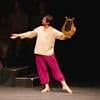
In the early years of cinema, going to the movies was a glamorous affair akin to attending the theater. But sometime after the advent of big-screen television, the silver screen began to lose its sheen. Audiences wised up — why sit in a sticky, soda-stained seat at some over-airconditioned megaplex when you could replicate the experience for a fraction of the cost in the comfort of your living room?
In the last few decades, the classical music world has attempted to restore cinema to its former glory by bringing back live musical accompaniment, transforming a trip to the movies into a concert-like occasion. Many orchestras, including the S.F. Symphony, perform Hollywood scores alongside screenings of the original prints. In 1994, Philip Glass developed a new opera/film hybrid by replacing Georges Auric’s soundtrack for Jean Cocteau’s La Belle et la Bête with his own music, placing soloists off to the side who sing the lines in sync with movie stars’ mouths.
Silent film provides a particularly intriguing challenge to composers — a music-less drama just waiting to be filled with something other than stereotyped nickelodeon leitmotifs, like the melodramatic “Big Chase” theme. This has become something of a specialty for Argentine-born, French-based composer Martin Matalon. Since 1995, he has written soundtracks for five silent films, including Fritz Lang’s Metropolis and features by Luis Buñuel. On Sunday at Cal Performances’s Zellerbach Playhouse, conductor David Milnes led UC Berkeley’s contemporary music group-in-residence eco ensemble in the U.S. premiere of Matalon’s score for The Oyster Princess, a 1919 film by German director Ernst Lubitsch.
In a lengthy pre-show interview with Cal Performances Executive Director (and fellow Argentino) Matías Tarnopolsky, Matalon laid out his aesthetic approach to film composition. He explained that he doesn’t write in “an illustrative manner” but rather creates “an equal partnership between music and images — not the music always subdued to the images.” He likened it to a kind of friendly relationship, with points of convergence between score and screen, but also “unpredictable” passages in which the two elements depart. In fact, to draw a distinction between his music and Lubitsch’s film, he gave his soundtrack its own title: Foxtrot Delirium.
But his statements raise some questions — why compose for film in the first place if your intentions aren’t to illustrate the action? Why not guarantee complete creative freedom and forego the movie entirely?
At certain points, the music did line up with what was happening onscreen as the orchestra provided “Mickey Mousing” evocations of movement or Foley-like sound effects. Huffing woodwind air-tones stood in for an oversized cigar, muted trumpet squeals for laughter, a tinkling triangle for a kiss, etc. Matalon was especially good at capturing the numerous tableaux of butlers and maids going about their chores in perfect unison like some choreographed Busby Berkeley number. The composer matched this overflowing mise-en-scène with his own hypercomplex polyphony. Tangles of independent instrumental lines overlapped to conjure the frenetic quality of a painting by Jackson Pollock or Joan Miró.
The only problem was that this cartoonish clutter of noise extended into scenes of relative inactivity, making for a baffling cinematic experience. In a segment involving two more-or-less stationary men in a cramped apartment, Matalon’s chaotic sonorities were more suggestive of a wild orgy. This constant musical frenzy, implying frantic movement or agitated emotions that weren’t there, made for a confusing sensory overload that sabotaged the visuals — it was not so much a marriage of image and sound, but a domestic squabble.
This kind of cognitive dissonance is more in line with an experimental art flick than a lighthearted screwball comedy. Lubitsch’s film may not be the best example of silent film, lacking the heart of a Charlie Chaplin feature, but it has some laugh-out-loud moments that demand a more accessible musical language than Matalon’s alienating sound world.

The movie depicts an American oyster magnate who marries his spoiled daughter Ossi off to a gold-digging prince. Only, it’s not the prince whom she weds, but his best friend Josef who goes in his stead. Eventually, Ossi encounters the real prince who, in a drunken state, stumbles into a meeting of the Multi-Millionaires’ Daughters Association Against Dipsomania. She falls for this despicable “prince charming,” and the two are left to wallow in each other’s depravity.
Though The Oyster Princess is a rather cynical depiction of capitalist corruption and greed, it’s by no means the nightmare suggested by Matalon’s terrifying soundscapes. I would have enjoyed his mesmerizing textures in a standalone piece, but in this context, they totally undermined Lubitsch’s intentions. Electronic effects generated from instrumental material echoed throughout Zellerbach Playhouse, producing an ominous atmosphere, as if something sinister were lurking in the shadows. Lubitsch’s comedy was transformed into an expressionist horror film along the lines of Nosferatu or The Cabinet of Dr. Caligari.
The only sequence that felt vaguely cinematic was the big foxtrot number alluded to in the title of Matalon’s score. In a surreal bit of doubling, a small dancehall orchestra appeared onscreen above the twelve-piece eco ensemble. Living string players and percussionists dubbed over their celluloid doppelgängers with jazz-inflected rhythms and licks; actors photographed a hundred years ago danced to present-day music they couldn’t hear.
Transcendent musical moments like this can help to revitalize interest in silent masterpieces that are beautifully shot, but frankly a little boring for contemporary audiences weaned on sound film. (I would love to hear what an imaginative composer could do with Georges Méliès’s phantasmagorical shorts.) However, film scoring requires a degree of humility — an artist can maintain stylistic integrity but must be willing to compose in service of the moving picture without blatantly disregarding the spirit of the film.




